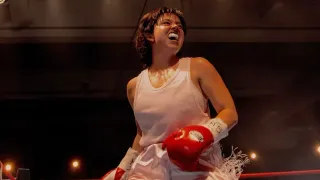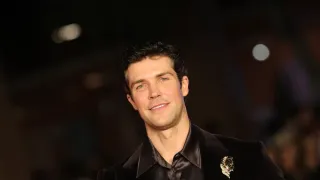December 13, 2022
Review: Starr-gazing – 'Remember Me, Vicki Starr: The Visual History of a Trans Renegade' Uncovers an Unknown History
Michael Flanagan READ TIME: 8 MIN.
The strip clubs and topless bars in North Beach were a bawdy and assertive reminder of sexuality (albeit heterosexuality) in an otherwise touristy neighborhood. I often wondered if members of the LGBTQ community worked in these clubs.
The 2021 photography book "Remember Me, Vicki Starr: The Visual History of a Trans Renegade" by Albert Tanquero and Lewis Rawlinson definitively answers this question. As ephemera in the book reveals, Vicki Starr (stage name for Victoria Fernandez) began working in the clubs of North Beach in 1965.
The Renegade
The book evokes the excitement of discovery over a new addition to our history and feelings of loss over what has been forgotten. Photographs in the book were found, much like the photographs of Vivian Maier or the letters in "P.S. Burn This Letter Please." Albert Tanquero, who compiled the photographs, tells the story in the foreword:
"I received a phone call from an antique dealer who had just acquired a suitcase full of photographs and ephemera," said Tanquero. "He wanted to know if I was interested in it. Little did I know, this suitcase contained the life of a trans Latina renegade. It consisted of hundreds of photos, slides, and newspaper clippings saved over decades by a trans woman that had migrated from Puerto Rico to New York City to San Francisco."
The foreword, the only two pages of text in the book outside of the ephemera and the sources, reveals the suitcase was found in a storage locker among the possessions of the late Dr. Horacio Roque Ramirez, a scholar of Chicano and Chicana Studies at UC Santa Barbara, who died unexpectedly at 46 in 2015.
Because of the limited text, casual readers might find the photos a bit difficult to understand, particularly since they have no captions. For example, a man appears in several photos from the 1950s and '60s with Vicki, but there is no way to know their relationship. The site "A Gender Variance Who's Who" indicates that Victoria had several husbands, and I wondered if this gentleman was one of them.
Sexual Pioneer
However, the book is a visual treasure trove and a starting point for puzzling together information on this intriguing sexual pioneer. The ephemera is particularly helpful in this regard, and I suggest that readers use this section to refer back to the photos.
One thing noticeable in the ephemera is that Starr is referred to in ads from the El Cid, Pierre's and Coke's as "Mr. Vickie Starr." This is probably due to the 1898 San Francisco Board of Supervisors Order No. 1587 §20, which made appearing "in a dress not belonging to his or her sex" a misdemeanor punishable by a thousand dollar fine or six months in jail – or both (a law in effect until 1974).
That's the reason José Sarria had people in drag at the Black Cat wear the notification "I am a boy" and performers like Lynne Carter performed at Finocchio's as "Mr. Lynne Carter."
P.R., Sweetie
Starr made the best of a discriminatory era and had an eye for PR. An ad in the June 7, 1968 Bakersfield Californian for Starr at the Rendezvous Club (3933 S. Chester, Bakersfield) has the headline "I Want To Change My Sex - Would You Believe I'm A Man?"
There are ads for Starr's performances in August 1967 at the 3000 Club in Oxnard and from Cisco & Bob's Hi 14 Club in Oakland (4345 E. 14th Street). Starr's talent gave her access to places you would not expect to see a transgender performance in the 1960s.
Though Vicki Starr was transgender, some ads from this era incorrectly refer to her as a female impersonator. However, Merla Zellerbach's San Francisco Chronicle column "My Fair City" from March 27, 1967, entitled "Transsexuals – The Story of Vicki Starr," allows Vicki to tell her own story:
"'I'm very much in love with a man,' says (Mr.) Vicki Starr, topless male dancer at Pierre's on Broadway. 'And I'm working for one reason – to earn money to pay for the conversion operation. As soon as it's finished my fiancé and I will get married, possibly adopt children and settle down quietly in Europe. No one will know my history.'"
The article also reveals why Starr moved from Puerto Rico to New York:
"My father couldn't stand me. I was too feminine."
Newspapers being what they were in 1967, the article describes being transgender in an insulting manner:
"It is far more complex – disturbing. Most transsexuals, according to the current Esquire, 'look like the hottest of flaming faggots, 'but are 'NOT homosexual.' "
Topless Turn
These attitudes weren't uncommon. Starr faced it elsewhere in the Chronicle. A Herb Caen column from April 6, 1967 (not in the book) referred to an upcoming performance by Starr:
"Mama Gaye Spiegelman talked her estranged husband, Jack, into hiring Vicki Starr, the transsexual topless, for his nightclub in Santa Rosa, the Hacienda. "I think Santa Rosa needs something like this," says Mama gravely and "something" is indeed the word."
Starr was transgender and visible when it was little understood or supported. She did topless dancing when it was still controversial. Starr was performing in San Francisco strip clubs by September 1965 (a performance in the ephemera is dated 9/24/65). That's 14 months after Carol Doda first performed topless at the Condor (on June 22, 1964) and introduced the '60s wave of topless dancing. It's also five months from the first police raids on topless clubs in San Francisco (on April 22 1965) and a year before the Compton's Cafeteria riot.
The photos follow Starr from her early years in Puerto Rico and New York, to her performance career in California and into her later years. They evoke a lost hidden world, much like Nan Goldin or Diane Arbus photos, and would make a wonderful museum exhibition.
There is one possible connection to Arbus: in a performance lineup from 1965, one of the performers is Peaches Palmer. Arbus photographed a stripper by that name in Atlantic City in 1963. It's not a stretch to think they are the same performer.
The ephemera and photos continue into the '70s and '80s with a poster from Project Artaud's "Ball of Balls" in 1971, an ad for a performance with Vicki Marlane at Jackie D's and a ticket from an AIDS benefit for "Boys Will Be Girls" at the Déjà vu in 1984 (the Déjà vu became The Black Rose in 1985). I was delighted to find a photo of Starr taken by Polly Polaroid in 1979 at the Queen Mary Pub (now Aunt Charlie's).
Hats Off
The book prompted me to see what else I could find out about Starr. Among my discoveries was a review of the performance at Jackie D's in the Empress Connection column of the Bay Area Reporter from May 16, 1973:
"A tremendous show of real talent shown by choreographer Skip Gilman. Talents used were Vicki Marlane, Victoria Star [sic] and Terry Taylor and dancers. Lennie Lynn did a fantastic job in the show. Hats off!"
I discovered a footnote in an article entitled "Introduction: Homoerotic, Lesbian, and Gay Ethnic and Immigrant Histories" from the Journal of American Ethnic History, in which Roque Ramírez recounts an interview with Starr where she reveals she:
"Migrated to New York City in the late 1940s with the support of members of an extended Puerto Rican lesbian softball network; also migrating to New York City from Puerto Rico at the time."
I asked friends living in San Francisco in the '70s if they remembered Starr. A few did. Michael C. Anstadt, who was a bartender at the Red Lantern Saloon, told me she performed at the Landmark (45 Turk) in the '70s and early '80s. Coy Meza remembered her as performing at Esta Noche on 16th Street.
One intriguing item I found regarding Starr's performances comes from The Gay Crusader (October 15, 1980) in an obituary for the female impersonator Adrian Ames:
"The Adrian Ames Review appeared at the old Follies Burlesque, where he was featured with others of his review (including Vicki Starr) in the 'Battle of the Sexes,' which was when the females and female impersonators danced on stage against one another and most often the men in the audience didn't know the difference."
Starr had a vibrant life, and was a true pioneer who deserves to be remembered. This book is a tribute and a step toward reclaiming her memory. There may be more to come. Roque Ramirez noted in the Journal of American Ethnic History article that he taped interviews with Starr in 2000. The tapes were lost, but perhaps "Queer Latino San Francisco: An Oral History, 1960s-1990s" by Roque Ramizez (coming from Springer Nature in 2025) will provide transcripts of these interviews. Meanwhile this book lets us enjoy fascinating images of a performer in a world previously unimagined.
'Remember Me, Vicki Starr: The Visual History of a Trans Renegade' is available at www.vickistarr.com
Help keep the Bay Area Reporter going in these tough times. To support local, independent, LGBTQ journalism, consider becoming a BAR member.






